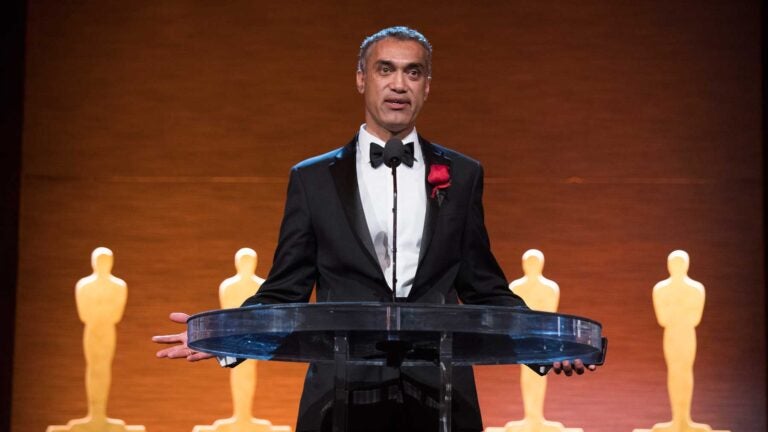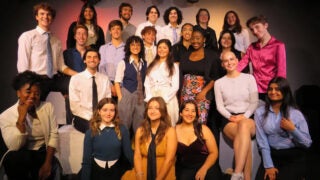
Parag Havaldar accepts his award at the Academy of Motion Picture Arts and Sciences’ Scientific and Technical Achievement Awards. (Photo/Richard Harbaugh/AMPAS)
USC alum helps Hollywood filmmakers create tech movie magic
Parag Havaldar’s expertise with facial-capture technology leads to an Oscar for visual achievement at 85th Scientific and Technical Awards ceremony
https://www.youtube.com/watch?v=cvu-JCaoWxU
Parag Havaldar ’96 PhD is an expert in facial-capture technology — and that expertise led to a face-to-face meeting with Oscar.
For 12 years, Havaldar was part of research and development teams working with top Hollywood directors on special effects-driven films like The Polar Express, Monster House, Hancock, Watchmen and Alice in Wonderland.
On Feb. 9, his expertise led to the Academy of Motion Picture Arts and Sciences’ 85th Scientific and Technical Awards, where he won an Oscar for his work in the development of facial performance-capture technology with Sony Pictures Imageworks.
In each film, Havaldar toyed with formulas and mechanisms that set up animation rigging and image capture for facial expressions — the skeleton that animators and filmmakers then use to paint vibrant photorealistic, or, in the case of Monster House, exaggerated depictions of actors’ faces in surreal worlds.
The elaborate process makes the impossible seem real. It’s how a house can turn into a face, with the door used as a mouth to suck children in. It’s how Alice can fall into a world with Tweedle Dee and Tweedle Dum. As distorted as it may seem, it all feels real, but this type of big-screen magic is not easy to execute.
“Every project is different in its requirements and different in its technological needs,” said Havaldar, who teaches a graduate course on multimedia in the Department of Computer Science at the USC Viterbi School of Engineering. “I can say with a great deal of happiness that working on set was the most important part of my experience. I got to work with the directors and received their input.”
Ray Feeney, past Academy Award winner and chair of the Scientific and Technical Awards committee, said: “With their outstanding, innovative work, these technologists, engineers and inventors have significantly expanded filmmakers’ creative choices for moving image storytelling.”
Understanding technology
Other researchers build off of Havaldar’s data and software to create advancements in visuals.
“If you are in the artistic side of things, understanding technology and how to harness it is very crucial,” Havaldar said. “Similarly, coming from the technology side, you have to understand artistic requirements. Only then can you write software or processes that can be used by artists to create the art form that they want.”
The funny part is Halvadar didn’t even know he had won an award. He had shifted from working in the film industry to gaming in the past couple of years, and he didn’t quite have his eyes on the prize. In fact, he had accidentally left his phone in the car the night the announcements were made to the nominees.
Halvadar had come across it the following morning in the form of a radio announcement highlighting the technological achievement in the movies he had worked on. After quickly returning home to look up the information, he realized that he had actually won an Oscar.
“It caught me completely by surprise,” he said.
The next adventure in storytelling
Proud of his accolades in film, Halvadar’s next step in his career will be taken in gaming at Blizzard Entertainment.
“With the growing modes of interaction in gaming, from virtual reality to immersive storylines that deal with a lot more than a point-and-shoot clicker, games are set to overlap or even overtake movies,” he said.
Whatever the medium, Havaldar hopes to continue creating new tools for storytelling.
“Stories are all about experiences, experiences are all about characters, or rather actors, and actors communicate through facial expression. So being able to capture that has really been a rewarding experience for me.”



